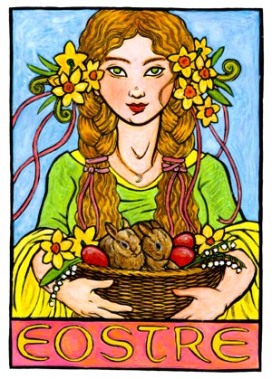Ēostre (Ostara, Ēastre) is an obscure Germanic and Anglo-Saxon goddess of spring and dawn, and is thought to be the namesake of the Christian holiday Easter. Her festival is celebrated on the Vernal Equinox, the first day of Spring.
 The cleric Bede first described Ēostre in his book De Temporum Ratione in the 8th century. However material related to her is so minimal that some scholars argue that she was never a goddess at all. Her name could have been derived from Ēosturmōnath, the Germanic name for the month of April. The High German word for Ēostre is Ostara.
The cleric Bede first described Ēostre in his book De Temporum Ratione in the 8th century. However material related to her is so minimal that some scholars argue that she was never a goddess at all. Her name could have been derived from Ēosturmōnath, the Germanic name for the month of April. The High German word for Ēostre is Ostara.
Her name is thought to mean “to shine”, therefore Ēostre is seen as a goddess of the dawn. However, it is also thought that Ēastre is the ancient word for “spring”. There are also links to the name Ēostre and “east”, the direction of the sky where the sun first rises, which gives Ēostre the name “Eastern Star”.
Through her association with dawn, Ēostre may be related to the Greek Eos, Roman Aurora, or Indian Ushas.
Ēostre is connected with growth, renewal, abundance, new beginnings and fertility. As symbols of rebirth and fertility, eggs and rabbits are sacred to her, as is the full moon. Ēostre represents the transitional time between childhood innocence and adult passion, and reminds us that life is full of untold possibilities and adventures.
Thalia Took – Eostre
Wiki – Eostre
Goddess Alive
© A Year And A Day (2013)


